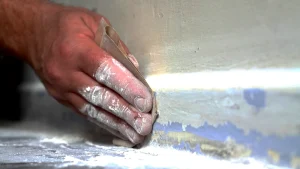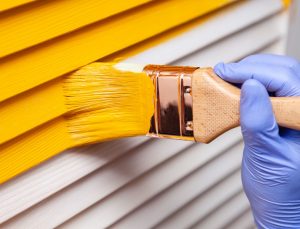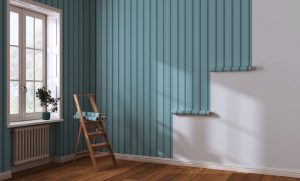Why Can’t You Paint Over A Damp Wall?
SB Decorations know too well that you can not paint over a damp wall without potentially serious consequences. First and foremost, painting over damp walls without treatment will allow the damp patches to continue causing damage to your walls. This will happen underneath the fresh layer of paint and over time your new paint will become damp.
As well as this, if your wall has mould patches on then even wiping it off can leave mould infested particles underneath. And the mould will end up returning. For this reason, it is important to know how to treat damp walls before painting.
Remove Mould or Damp Stains
Firstly, it’s important to tackle the mould and damp stains on your wall and/or ceilings. You need to use a specialist cleaning solution as standard bleach or other household cleaners might not kill the mould spores.
You should also wear appropriate clothing including gloves, goggles and a mask to avoid coming into contact with the mould spores. Clean the area using a brush or sponge and the specialist damp/mould remover.
Once this is done, you should leave it to dry.
Fill in Holes and Cracks
After you have removed the damp and mould, you should be able to see if there are any cracks or holes in your walls. If you notice any, it’s important to fill them in before painting. If you don’t, it is likely that the damp will return and/or the paint will crack.
Use a good quality filler and smooth over the area until it’s level with the rest of the wall. Once this is done, leave it to dry completely.
Sand Down The Wall
The next thing to, do after sealing, is to sand the wall down. There are many benefits to sanding down your walls which include ;
– It creates a smooth surface for the paint to adhere to
– It helps the paint to last longer as it can’t peel off as easily
– It’s a good opportunity to check if there are any more cracks or holes that need filling in
Use fine sandpaper and lightly sand over the entire wall.
Wash Away the excess
After you have sanded down your used-to-be damp wall, you should wash away the excess dust. Excess dust may stay on the wall from the sanding process which would cause small bumps on the fresh layer of paint. Use a sponge to wash and wipe any dust off your walls.
Apply a Waterproof Seal
Finally, before painting, we recommend applying a waterproof seal. Waterproofing your walls will help to protect them from any future damp damage as well as provide an extra layer of protection against the damp.
Once you have applied the seal, leave it to dry completely. And that’s it! Your wall should now be ready for painting.
Hire Professionals
If you are not that experienced with painting, we suggest you hire professional workmen to decorate your home. Hiring a professional will give you the guarantee that your walls are treated properly and the job is done right.
If you have any questions or would like a free quote, please do not hesitate to contact SB Decorations. We provide painters and decorators in Cambridge and nearby surrounding areas.







